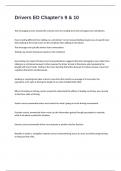Drivers ED Chapter's 9 & 10
Text messaging correct answersthe common term for sending short text messages from cell phones.
How is texting different from talking on a cell phone? correct answersTexting requires you to spend more
time looking at the small screen on the cell phone than talking on the phone
Text messages are typically shorter than conversations
Texting may involve having two hands on the cell phone
How texting can impact driving correct answersEvidence suggests that text messaging is even riskier than
talking on a cell phone because it often requires the driver to look at the phone and manipulate the
keypad with one's hands. Texting is the most alarming distraction because it involves manual, visual and
cognitive distraction simultaneously.
Sending or receiving text takes a driver's eyes from the road for an average of 4.6 seconds, the
equivalent at 55 mph of driving the length of an entire football field, blind.
Effects of texting on driving correct answersTo understand the effects of texting on driving, you can look
at the three tasks of driving:
Search correct answersthe driver must search for what's going on in the driving environment
Evaluate correct answersthe driver must use the information gained through perception to evaluate
what to do about a particular situation
Execute correct answersthe driver must execute or perform his/her decision
Benefits of audio or navigation systems correct answersHaving access to music and other programming
to help pass the miles
,Gaining the latest information on local, national and international events
Obtaining road travel reports on weather, construction, road closures and crashes
Used wisely, audio systems can help keep drivers' minds engaged
Help with finding an unfamiliar route or location
Potential distractions regarding audio and navigation systems correct answersAdjusting the vehicle's
audio controls or navigation tools
- Research shows that young drivers are especially susceptible to becoming distracted while attempting
to adjust their vehicle's audio controls.
- Adjusting any vehicle's audio controls almost always involves the driver reaching for a knob or button.
Often, this action requires that the driver's eyes be diverted from the driving scene for some period of
time.
- Moving one's eyes and having to refocus on the shorter distance between the eyes and the dash or
steering wheel, even for a short time, can result in a complete discontinuation of visual feedback from
the driving scene.
Setting the audio system volume too loud
A driver could miss out on important information that is obtained through the ears, including:
emergency vehicle's sirens, horns or screeching tires.
Vehicle Passengers correct answersTalking to or yelling at the driver
Throwing objects inside or outside the vehicle
Partially hanging out of the vehicle
,Yelling at persons outside the vehicle
Unexpectedly adjusting audio system controls
Unexpectedly adjusting vehicle controls
Much more...
Research indicates that, for young drivers, the greater number of similarly-aged occupants aboard, the
more likely a crash is to occur. This is a major reason why many states' graduated driver licensing systems
restrict the number of similarly-aged passengers that can be in a vehicle with a novice driver.
Potential Distractions Outside the Vehicle correct answersOutside traffic - vehicle swerved, turned in
front of, changed lanes, slowed or stopped, encroached on lane
Crash scenes / rubbernecking
Animal in or near roadway - deer, dog, other animal
Road construction
People / objects in roadway - child in road, people walking, basketball game, crowd, broken glass,
garbage can, etc.
Other vehicles
Police - someone pulled over, someone being chased by police, officer directing traffic, someone thought
they saw police
Reading billboards or other road advertisements
, Sunlight / sunset
Other - waved ahead by driver, another person or driver, parachutes in sky, bicycle, toll booth, bush
obstructing vision, tire blowout, etc.
Crash scenes (Rubbernecking) correct answersCertainly a crash scene would have the ability to grab a
driver's attention. However, it has been found that crash scenes also tend to hold a driver's attention,
keeping him or her from focusing on the driving task. Thus, some drivers tend to maintain eye contact
with a crash scene, even beyond the point that they pass the scene. This phenomenon, sometimes
referred to as "rubbernecking," can be quite dangerous, increasing the chance of experiencing a
collision.
Cell phones correct answersThe best practice would be to refrain from talking on a cell phone while
driving. Utilize voice mail or other passengers for help with taking cell phone calls or text messages. Pick
up your messages later, once you have completed driving. In emergency situations, it is the responsibility
of the driver to use his/her best discretion. If you have to call or text, pull off the road safely or and stop
or stop in a safe parking area (depending on the urgency of the situation, drivers must use their best
judgment)
Audio and navigation systems correct answersAdjust vehicle controls before you begin your trip, take
advantage of normal stops to adjust controls.
Minimize any adjustment to the audio or navigation system while driving.
Ask passengers to adjust controls or input navigation information.
The audio system's volume should be put at a level that always permits the driver to be fully aware of
any warning sounds in the traffic environment.
Vehicle occupants correct answersIn the unlikely event of an extreme situation, the driver, who is
responsible for and in control of his or her vehicle, must decide whether an occupant or occupants
should be removed from the vehicle.




